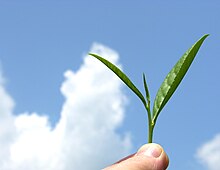Tea has been around for a long, long time, since about 3000 BC, 2737 BC to be more exact and it was discovered by the wife of a Chinese Emperor by the name of Shen Nung and later became a domesticated crop during the Shang Dynasty (1600 BC to 1100 BC (approximate dates).
The legend is that the emperor’s wife was boiling some water in a pot to prepare refreshment to serve her husband and guest when some leaves from the bush nearby fell into the boiling water. Before the leaves could be removed they began to steep or brew and from it wafted a deliciously sweet aroma that pleased the emperor’s wife but she feared serving this beverage to the emperor and his guest with leaves it. She would have to start over; she thought to herself but worried because the guests were expecting to be served shortly.
The emperor’s wife had no time to prepare new water since the guests were already waiting so she quickly skimmed away the leaves and served what she had prepared with the water she already had. The result was that the emperor and guest were so pleased and delighted with this wonderfully different refreshment that they questioned the wife as to how she had prepared such a delicious and soothing drink.
Reluctantly she confessed what had happened and fully expected her husband’s wrath to fall upon her but instead something quite different happened; her husband and his guests praised her for her ingenuity and the word was spread throughout the countryside about the delicious brew the emperor’s wife had served and tea before long became the most popular beverage on the planet aside from plain water.

Leaves of Camellia sinensis, the tea plant.
Soon the leaves of the camellia bush were being collected and brewed into this wonderful beverage all over China. The camellia soon became known as “the tea bush” and over the years several distinctive teas have been developed from the leaves of this fragrant and beautiful plant. It all originated in China but soon moved into India and later Japan and other places; and this is where our cup of tea began.
The word “tea” comes from China and is a word in the Xiamen dialect “te” pronounced “tay” and meaning any heated beverage.
Even a hot cup of water without any sort of seasoning or perhaps just honey and warm water would still be called “te” or “tay” in Xiamen Chinese.

Fresh tea leaves of different sizes. The smaller the leaf, the more expensive the tea
This is why all these herbal teas we have today can still justifiably be called tea even though they are not officially tea from the camellia or tea bush.
In India this drink is called “tay” which later was translated to the English word “tea,” this drink not being introduced in Europe until the mid-16th and early-17th centuries and was introduced to those tea-drinking Englishmen by the Dutch.






No comments:
Post a Comment